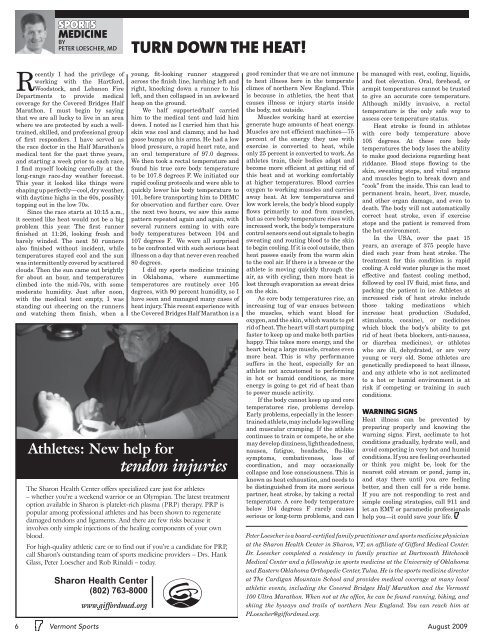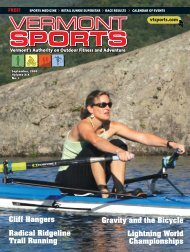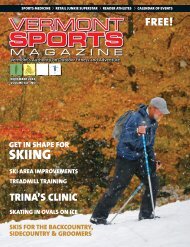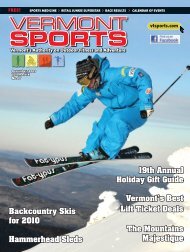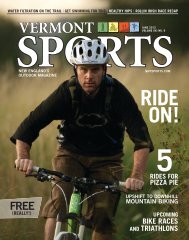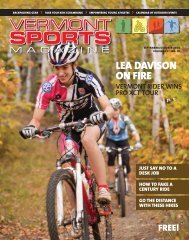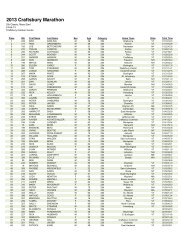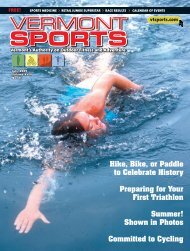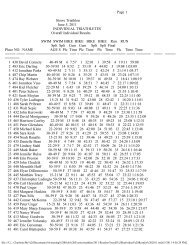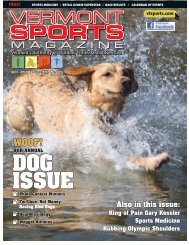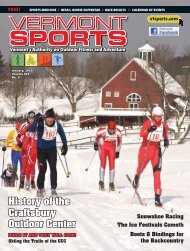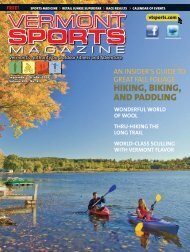August 2009 - Vermont Sports Magazine
August 2009 - Vermont Sports Magazine
August 2009 - Vermont Sports Magazine
You also want an ePaper? Increase the reach of your titles
YUMPU automatically turns print PDFs into web optimized ePapers that Google loves.
R<br />
SPORTS<br />
MEDICINE<br />
BY<br />
PETER LOESCHER, MD<br />
ecently I had the privilege of<br />
working with the Hartford,<br />
Woodstock, and Lebanon Fire<br />
Departments to provide medical<br />
coverage for the Covered Bridges Half<br />
Marathon. I must begin by saying<br />
that we are all lucky to live in an area<br />
where we are protected by such a welltrained,<br />
skilled, and professional group<br />
of fi rst responders. I have served as<br />
the race doctor in the Half Marathon’s<br />
medical tent for the past three years,<br />
and starting a week prior to each race,<br />
I fi nd myself looking carefully at the<br />
long-range race-day weather forecast.<br />
This year it looked like things were<br />
shaping up perfectly—cool, dry weather,<br />
with daytime highs in the 60s, possibly<br />
topping out in the low 70s.<br />
Since the race starts at 10:15 a.m.,<br />
it seemed like heat would not be a big<br />
problem this year. The fi rst runner<br />
fi nished at 11:26, looking fresh and<br />
barely winded. The next 50 runners<br />
also fi nished without incident, while<br />
temperatures stayed cool and the sun<br />
was intermittently covered by scattered<br />
clouds. Then the sun came out brightly<br />
for about an hour, and temperatures<br />
climbed into the mid-70s, with some<br />
moderate humidity. Just after noon,<br />
with the medical tent empty, I was<br />
standing out cheering on the runners<br />
and watching them fi nish, when a<br />
Sharon Health Center<br />
(802) 763-8000<br />
www.giffordmed.org<br />
TURN DOWN THE HEAT!<br />
young, fi t-looking runner staggered<br />
across the fi nish line, lurching left and<br />
right, knocking down a runner to his<br />
left, and then collapsed in an awkward<br />
heap on the ground.<br />
We half supported/half carried<br />
him to the medical tent and laid him<br />
down. I noted as I carried him that his<br />
skin was cool and clammy, and he had<br />
goose bumps on his arms. He had a low<br />
blood pressure, a rapid heart rate, and<br />
an oral temperature of 97.0 degrees.<br />
We then took a rectal temperature and<br />
found his true core body temperature<br />
to be 107.8 degrees F. We initiated our<br />
rapid cooling protocols and were able to<br />
quickly lower his body temperature to<br />
101, before transporting him to DHMC<br />
for observation and further care. Over<br />
the next two hours, we saw this same<br />
pattern repeated again and again, with<br />
several runners coming in with core<br />
body temperatures between 104 and<br />
107 degrees F. We were all surprised<br />
to be confronted with such serious heat<br />
illness on a day that never even reached<br />
80 degrees.<br />
I did my sports medicine training<br />
in Oklahoma, where summertime<br />
temperatures are routinely over 105<br />
degrees, with 90 percent humidity, so I<br />
have seen and managed many cases of<br />
heat injury. This recent experience with<br />
the Covered Bridges Half Marathon is a<br />
Athletes: New help for<br />
tendon injuries<br />
The Sharon Health Center offers specialized care just for athletes<br />
– whether you’re a weekend warrior or an Olympian. The latest treatment<br />
option available in Sharon is platelet-rich plasma (PRP) therapy. PRP is<br />
popular among professional athletes and has been shown to regenerate<br />
damaged tendons and ligaments. And there are few risks because it<br />
involves only simple injections of the healing components of your own<br />
blood.<br />
For high-quality athletic care or to find out if you’re a candidate for PRP,<br />
call Sharon’s outstanding team of sports medicine providers – Drs. Hank<br />
Glass, Peter Loescher and Rob Rinaldi – today.<br />
good reminder that we are not immune<br />
to heat illness here in the temperate<br />
climes of northern New England. This<br />
is because in athletics, the heat that<br />
causes illness or injury starts inside<br />
the body, not outside.<br />
Muscles working hard at exercise<br />
generate huge amounts of heat energy.<br />
Muscles are not effi cient machines—75<br />
percent of the energy they use with<br />
exercise is converted to heat, while<br />
only 25 percent is converted to work. As<br />
athletes train, their bodies adapt and<br />
become more effi cient at getting rid of<br />
this heat and at working comfortably<br />
at higher temperatures. Blood carries<br />
oxygen to working muscles and carries<br />
away heat. At low temperatures and<br />
low work levels, the body’s blood supply<br />
fl ows primarily to and from muscles,<br />
but as core body temperature rises with<br />
increased work, the body’s temperature<br />
control sensors send out signals to begin<br />
sweating and routing blood to the skin<br />
to begin cooling. If it is cool outside, then<br />
heat passes easily from the warm skin<br />
to the cool air. If there is a breeze or the<br />
athlete is moving quickly through the<br />
air, as with cycling, then more heat is<br />
lost through evaporation as sweat dries<br />
on the skin.<br />
As core body temperatures rise, an<br />
increasing tug of war ensues between<br />
the muscles, which want blood for<br />
oxygen, and the skin, which wants to get<br />
rid of heat. The heart will start pumping<br />
faster to keep up and make both parties<br />
happy. This takes more energy, and the<br />
heart being a large muscle, creates even<br />
more heat. This is why performance<br />
suffers in the heat, especially for an<br />
athlete not accustomed to performing<br />
in hot or humid conditions, as more<br />
energy is going to get rid of heat than<br />
to power muscle activity.<br />
If the body cannot keep up and core<br />
temperatures rise, problems develop.<br />
Early problems, especially in the lessertrained<br />
athlete, may include leg swelling<br />
and muscular cramping. If the athlete<br />
continues to train or compete, he or she<br />
may develop dizziness, lightheadedness,<br />
nausea, fatigue, headache, fl u-like<br />
symptoms, combativeness, loss of<br />
coordination, and may occasionally<br />
collapse and lose consciousness. This is<br />
known as heat exhaustion, and needs to<br />
be distinguished from its more serious<br />
partner, heat stroke, by taking a rectal<br />
temperature. A core body temperature<br />
below 104 degrees F rarely causes<br />
serious or long-term problems, and can<br />
be managed with rest, cooling, liquids,<br />
and foot elevation. Oral, forehead, or<br />
armpit temperatures cannot be trusted<br />
to give an accurate core temperature.<br />
Although mildly invasive, a rectal<br />
temperature is the only safe way to<br />
assess core temperature status.<br />
Heat stroke is found in athletes<br />
with core body temperature above<br />
105 degrees. At these core body<br />
temperatures the body loses the ability<br />
to make good decisions regarding heat<br />
riddance. Blood stops fl owing to the<br />
skin, sweating stops, and vital organs<br />
and muscles begin to break down and<br />
“cook” from the inside. This can lead to<br />
permanent brain, heart, liver, muscle,<br />
and other organ damage, and even to<br />
death. The body will not automatically<br />
correct heat stroke, even if exercise<br />
stops and the patient is removed from<br />
the hot environment.<br />
In the USA, over the past 15<br />
years, an average of 375 people have<br />
died each year from heat stroke. The<br />
treatment for this condition is rapid<br />
cooling. A cold water plunge is the most<br />
effective and fastest cooling method,<br />
followed by cool IV fl uid, mist fans, and<br />
packing the patient in ice. Athletes at<br />
increased risk of heat stroke include<br />
those taking medications which<br />
increase heat production (Sudafed,<br />
stimulants, cocaine), or medicines<br />
which block the body’s ability to get<br />
rid of heat (beta blockers, anti-nausea,<br />
or diarrhea medicines), or athletes<br />
who are ill, dehydrated, or are very<br />
young or very old. Some athletes are<br />
genetically predisposed to heat illness,<br />
and any athlete who is not acclimated<br />
to a hot or humid environment is at<br />
risk if competing or training in such<br />
conditions.<br />
WARNING SIGNS<br />
Heat illness can be prevented by<br />
preparing properly and knowing the<br />
warning signs. First, acclimate to hot<br />
conditions gradually, hydrate well, and<br />
avoid competing in very hot and humid<br />
conditions. If you are feeling overheated<br />
or think you might be, look for the<br />
nearest cold stream or pond, jump in,<br />
and stay there until you are feeling<br />
better, and then call for a ride home.<br />
If you are not responding to rest and<br />
simple cooling strategies, call 911 and<br />
let an EMT or paramedic professionals<br />
help you—it could save your life.<br />
Peter Loescher is a board-certifi ed family practitioner and sports medicine physician<br />
at the Sharon Health Center in Sharon, VT, an affi liate of Gifford Medical Center.<br />
Dr. Loescher completed a residency in family practice at Dartmouth Hitchcock<br />
Medical Center and a fellowship in sports medicine at the University of Oklahoma<br />
and Eastern Oklahoma Orthopedic Center, Tulsa. He is the sports medicine director<br />
at The Cardigan Mountain School and provides medical coverage at many local<br />
athletic events, including the Covered Bridges Half Marathon and the <strong>Vermont</strong><br />
100 Ultra Marathon. When not at the offi ce, he can be found running, biking, and<br />
skiing the byways and trails of northern New England. You can reach him at<br />
PLoescher@giffordmed.org.<br />
6 <strong>Vermont</strong> <strong>Sports</strong> <strong>August</strong> <strong>2009</strong>


